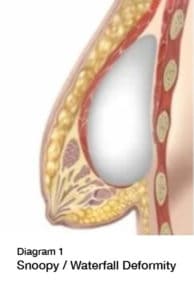How long do breast implants last?
Nothing lasts forever right? Although breast implants don’t officially expire like the things you may buy from the supermarket; they are not designed to last a lifetime either.
The current guidance is that the average breast implants lasts 10 years.
However some women find their implants last much longer before they need to book in for breast implant removal and replacement surgery whilst others find that they need removing much sooner before this 10-year anniversary. So how do you know when your implants are at the end of their lifespan? Read on to find out!
What are the signs that my breast implants may need removing and / or replacing?
Hardening of the breast implant (Capsular Contracture)
Some women find that their breast implants do not last due to developing a capsular contracture or a hardening of the scar tissue ‘Capsule’ around one or possibly both of their implants. This ‘capsule’ is a local reaction from the body towards the “Foreign body” (i.e.) the implant. Think back to when your implants were originally placed. It is a natural body response for it to react to any foreign body that it detects and attempts to create a protective barrier by creating varying levels of scar tissue. In most cases this defensive barrier is a good thing as it aids in helping the implants to remain in the correct position. In a small number of patients however the build up of scar tissue causes problems: This scar tissue in one of both breasts goes unusually hard and starts to contract around the implant, causing both aesthetic problems as well as varying degrees of pain.
This usually happens within 2 years of the patient having initially had the breast surgery. However it can also be a symptom that the implant has reached the end of its lifespan and in patients who have had their breast implants for a number of years, it can be an indication that she needs to consider looking into ‘breast implant removal and replacement surgery’.
A grading system has been created to determine the severity of the capsular contracture.
Grade 1 Capsular Contracture
If you have been told that you have capsular contracture yet you are not experiencing any symptoms, then its likely you have a grade 1 issue. In this instance the build up of scar tissue around the implant does not cause any noticeable problems. You will experience no pain and there is zero interference with the size, shape or texture of the breast area. They will appear natural to the eye and feel soft to the touch.
Grade 2 Capsular Contracture
If you are experiencing minor cosmetic symptoms then you may be suffering with a grade 2 capsular contracture. The shape and size of the impact will appear normal, however it may feel firm to the touch.
Grade 3 Capsular Contracture
We are now getting into more serious waters when we get to a grade 3 capsular contraction. Although there may not be much, if any, pain present; the appearance of the breasts will appear abnormal and they will be much firmer to the touch. The shape will be overly round and hard looking in appearance and the placement of the nipples may appear to be misshapen.
They will look and feel very similar to a grade 3 capsular contraction, however there will be tenderness and pain felt to the touch.
Ruptures to the Implant
Saline Implant
If your implants are filled with saline you may suddenly find that they deflate like a balloon if the implant shell gets torn. In this scenario the saline that fills the implants will leak into and get absorbed by the body. This can be instantaneous and happen all at once or alternatively may occur over a number of days. Depending on the degree of the leak – you may be unaware that there is a problem until the breast has completely deflated, or looks different in shape and size to the other breast. The risk for ruptures in a saline implant does increase as the implant gets older, in regards to the date of the original surgery. Saline Implants do not usually last as long as silicone implants for this reason.
Silicone Implant
It’s not just saline implants that may suffer from a rupture to the shell: Silicone filled implants too, may suffer from shell damage in their lifetime of being within the body. Unlike the saline filled implant that may completely deflate with a rupture, the gel within a silicone implant is much thicker and hence the gel often stays within the implant or very close within the surrounding scar tissue.
Due to the fact that hardly any of the gel spills into the surrounding tissue, very often it goes unnoticed when silicone implants rupture. They are therefore often known as silent ruptures.
In a lot of cases there are zero symptoms to indicate a rupture. In instances when symptoms do present, you may experience any of the following:
- You may notice that your breast size suddenly appears smaller than before or that one breast is larger or a different shape than the other.
- You may feel pain and discomfort in the breast area or surrounding tissue.
- You may suddenly feel hard bumps in the implant.
- Tingling and / or swelling may present.
- You may suddenly feel numbness around the location of the implant or surrounding tissue.
- A burning or otherwise strange sensation may be detected within the breast area.
So in the quest to determine “how long do breast implants last”, If a rupture is to blame for the need for removal it really does depend in regarding to how long it would last from the initial surgery: An implant could have ruptured immediately after surgery, several years later, or in some instances 10 years or more after they were fitted.
How long do breast implants last – don’t newer implants have a lifetime warranty against rupturing?
Yes they do. It’s important to note that newer implants from top brands are under a full time warranty in regards to their structural make-up.
In other words, newer implants won’t rupture!!
Therefore this problem is associated with older implants.
Regardless of the age of the implant: If you suspect your implant has ruptured, whether its filled with silicone or saline, you will need to consider having the implant checked and if necessary discuss your options regarding having breast implant removal and replacement surgery (or just removed with or without a breast lift surgery if you not wanting to have them replaced).
Rippling to the implant
Some women may find that their implant develops ripples and wrinkles over time. This usually happens in women who are slim in appearance and therefore less of their natural breast tissue surrounds the implant. In some cases these ripples can be detected by touch only and in more severe cases the wrinkles may actually be seen through the skin. If this has happened to your implants you may wish to speak with a surgeon about having the old implants removed or replaced.
The implant changes in its position.
So what else should be considered when trying to discover the answer to the question ‘how long do breast implants last?’ The positioning of the breast implant should have a major role when determining whether you should be making that appointment with your surgeon to have breast implant removal and replacement surgery. There are a number of factors that may cause the implant to change position. The natural tendency for the breast to sag as the patient ages will still occur regardless of whether they have breast implants or not and gravity still be have a active role in the appearance of the breast. Therefore due to this natural aging process you may discover that one breasts hangs much lower than the other or your nipples start to point in a different direction.
Other factors that may affect the positioning of the implant include:
- Implant size; the trigger to a higher complication rates is bigger implants that are greater than >350cc in size
- weight gain after your breast surgery took place.
- Weight loss after your breast surgery took place
- pregnancy
Any of these factors can cause a change in the shape of the breast and may result in stretching and sagging of the skin and breast tissue. You may decide that in these instances your implants need replacing for cosmetic reasons rather than a structural concern and either a direct replacement or uplift will return your breasts to their former glory.
The snoopy or waterfall deformity
When you hear the name Snoopy, your mind may wander to images of the cute cartoon dog loved by millions of kids and adults alike. But did you know that it could also refer to a deformity involving breast implants. With a snoopy or waterfall deformity the breast tissue effectively separates from the implant, leaving a full upper pole cleavage area and a hanging natural breast. This can occur for a number of reasons. If a patient, who has quite a lot of loose and droopy breast tissue, opts for a breast augmentation without an uplift: They may find that as the normal effect of gravity takes hold the normal tissue effectively slides off the implant. This results in an undesirable shape to the breast, as the implants remain higher on the chest and the breast and nipple point downwards. Major weight increases can also aggravate this condition as it can affect the elasticity of the breast tissue. Finally some women find that pregnancy can cause a waterfall or snoopy deformity. During pregnancy and breastfeeding the breast can increase and then reduce quite considerably in size. This again can cause the breast tissue to effectively separate from the implant and the breast tissue then hangs below the implant. In this instance a breast uplift may be needed with or without replacement implants to return the breasts to their original perky appearance. More information on all the above can be found here.
So just how long do breast implants last?
How long do breast implants last? Well as this article shows – It depends! We now know that as the implant ages (in older breast implants) there could be structural as well as cosmetic reasons why you may decide that your implants need to be removed, caused by a variety of reasons. Newer breast implants are now designed in a way that massively reduces the risk of rupturing therefore any desires to replace newer implants are usually for more cosmetic reasons.
FREE consultation to determine the health of your implant
If you have any concerns regarding your old implants, whether they are 1, 5 or 25 years old, contact expert cosmetic surgeon Mr El Gawad to book a FREE consultation today: To discuss your situation in regards to whether your old implants need removing and whether a further breast augmentation with or without a breast uplift is needed in your individual case.
Alternatively if you have any general questions about breast implant removal and replacement surgery please feel free to comment at the bottom of this article.
Breast Implant Removal Before and After Photos
See before and after photos of real patients who have had implant removal surgery with Mr El Gawad.









